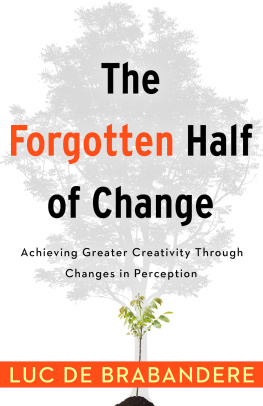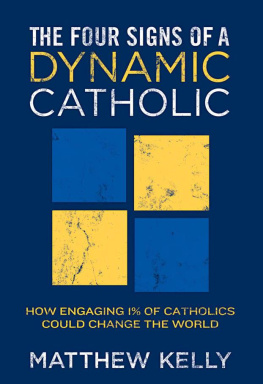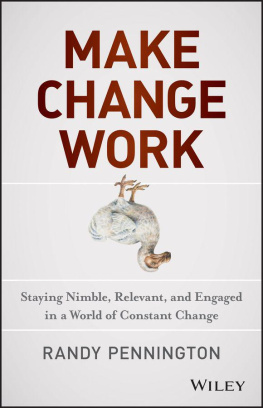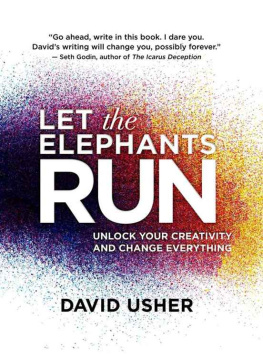The Forgotten Half of Change
Achieving Greater Creativity Through Changes in Perception
Luc de Brabandere
This book is dedicated to Arthur Janta-Polczynski (19492004) who gave me so many ideas.
My thanks to all my partners in the Boston Consulting Group, and a special thanks to Erik Calonius and Richard Hill, without all of whom this book would not have been possible.
Preface
A few years ago Bill Gates came to Brussels.
The head of Microsoft Belgium decided to mark the occasion by organizing a conference meeting for one thousand customers and users. Two months before the conference he asked me if I would be willing to give a short speech, first to present a few provocative, stimulating, and surprising ideas on developments in IT, then to introduce Bill Gates to his Belgian audience.
Of course, I accepted. My passion for ideas knows no bounds, and a few weeks later I was ready to make a creative presentation on the relationship between man and machines.
On the eve of the great day, around 8 oclock in the evening, the phone rang at home.
Youve forgotten to send the slides of your presentation, and Bill Gates would like to see them, said the head of Microsoft Belgium.
My reply was immediate: Most people in Belgium and France know full well that I never use slides. I prefer to practice the art of oratory as was done in old times. Ive got clear ideas and Im ready for my presentation tomorrow.
Silence.
Soyou have no slides?
No, I said for the second time. The spoken word and the written word are two different things. I use both but I never mix them. I give speeches, and I write books. The ideas are the same, but the way I express them is different. When I speak, its in real time. When I write, its in delayed timeits as if I were someone else.
Silence.
I was aware of the acute levels of worry building up on the other end of the line. So it was actually possible to make presentations without using PowerPoint! Whats more, in front of the spiritual father of PowerPoint? At that very moment, I realized that something had shattered in the mind of the person I was speaking to. That something has a name: a stereotype.
A stereotype is an idea that has taken shape one day and matured over timea stable idea, or a basic judgment. Stereotypes are the atoms of thought; they are the actual condition of thinking. All too often, we forget that our ideas are stereotypes. Thats when the misunderstandings occur.
I decided to be as comforting as I could: I didnt want to hurt my Microsoft host. So over the phone we drew up a short series of some ten slides. Its easy to do. I have clear ideas, and a logical sequence for the way theyre set out. The next day I made my presentation live, without text, standing in front of the audience of one thousand. After me, Bill Gates used PowerPoint. Maybe, when he was listening to me, he thought he should have done the same as me. But Im sure you understand why he was obliged to use slides.
Parenthetically, another IT supremo, Lou Gerstner of IBM, clearly understood the stereotype-reinforcing potential of PowerPoint. When he arrived at the companys Brussels headquarters, shortly after taking over to get a first briefing from IBMs European business unit managers, he flatly refused to let them use the system. He needed to know what kind of people he was dealing with, and he wanted to hear, observe and challenge the real thing.
So why do I tell the story about Bill Gates? Precisely because this book is a lot about stereotypes, and what we have to do to look and get beyond them.
Little revelations like my Microsoft experience come to me every day. They always have done. Creativity has been my passion since I was born and, for my 50th birthday, my dream came true: I made creativity my career. I now earn a living from my passion for new ideas. I like to understand where these new ideas come from and why, sometimes, they dont come; who has more of them than other people; how certain companies benefit from them to change the world; and so on. An IT engineer and mathematician by training, I worked for 20 years in the worlds of finance and technology until I became Director-General of the Brussels Stock Exchange. For me, my mid-life crisis was also the shattering of a stereotype.
I slowly passed from one life, where I enjoyed my career while being creative, to another where being creative was my career. The investment I made in myself was enormous. Psychoanalysis, authorship of four books, and a complete cycle of philosophy studiesthese were all essential. When you want to make ideas your career, you cant ignore the history of ideas and the incredible adventure of concepts.
Creativity in companies is what I do for a living today, but Im far from being the only onefortunately, since creativity is the life force of enterprise. What is original and special in what I do comes from the interface between this passion that has always been in me and the currents of thought which have always been around me.
I was born in 1948just like cybernetics! In that year Norbert Wiener published a seminal book with that title. He defined the discipline as the science of control and steering, and shed light on the importance of feedback mechanisms. My first contacts with control loops date back to my engineering studies, but I immediately had the feeling that this systems approach would never leave me. I didnt realize at the time the extent to which systems theories would fascinate me.
Again and again, I would study information and communications theory (Shannon, et al), game theory (Von Neumann, et al), ecology, linguistics, and so on. All these disciplines use systemic language to drive their respective scientific fields further forward.
But the most important thing for me was still to happen. That was meeting those people who put the concepts of feedback, paradox, and system to therapeutic use: the School of Palo Alto.
I read books by Watzlawick, Bateson, Hall, and others. Even if their objectives, confronted with suffering and illness, were far removed from mine, they were still facing the same problem as I was in the world of business: change.
One of their ideas appears to me to be of fundamental importance: to change, we have to change twice. Not only do we have to change things, but we have to change the way we see things.
One day I had a real revelation: I made the link between Palo Alto and my work. This is the key to the book you hold in your hands. I told myself that companies that want to change also have to change twice. Innovation is their peoples capacity to change reality, and creativity is the capacity of these people to change their perception of reality. While parallel, the processes are totally different, and they have to be rediscovered and the difference appreciated.
Now that I had this puzzle clear in my mind, I could devote myself more wholly to the piece of the puzzle that is change in perceptionthe instant of the new idea, creative and disruptive.
Since then Ive had moments of great satisfaction. One was after a speech I made in Stockholm during the final session of a CIES Congress, the annual event in the distribution sector. I had the honor of sharing the floor during two hours of plenary session with Desmond Tutu, the South African bishop and friend of Nelson Mandela.
After I had spent 60 minutes presenting the key concepts of creative thought to 500 big bosses of industry (without slides of course!), Desmond Tutu took the floor, andIm still getting over it todayasked the audience to give my ideas another round of applause.
The reason, he said, was that when apartheid was abolished in South Africa, the overwhelming majority of the countrys inhabitants could only envisage two possible scenarios.








